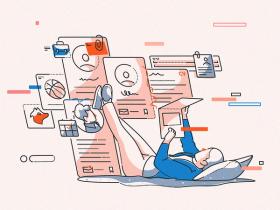Contents
IoT in the Fitness Industry: Devices, Use Cases & Tips
Published: February 26, 2024
25 min read
In this article, you'll learn:
1
📋 Fitness IoT Use Cases
2
🏆 Our Expertise in Wearables Integration: Platoon Fit & SportPlus
3
🤖 Internet of Things Tech Stack in the Fitness Industry: Devices & APIs
4
❓ FAQ on IoT in Fitness
5
💡 Takeaways
📋 Fitness IoT Use Cases
Internet of Things devices, supported by companion application development, have a truly broad application in the fitness industry, enhancing user engagement and personalization. They help to customize the user experience, enable immersive home training, and even offer easier equipment maintenance to those who have offline fitness studios.
Let’s review each one of these use cases in detail.
In case you need some additional information on fitness app development in general, feel free to take a look at our step-by-step guide that covers various details of this topic:
🏆 Our Expertise in Wearables Integration: Platoon Fit & SportPlus
Our team, including fitness mobile app developers, has extensive experience in integrating IoT devices with fitness products. In this section, we’re going to share how we developed MVPs for 2 outstanding fitness projects that featured heart rate sensors and exercise equipment — Platoon Fit and SportPlus.
Platoon Fit
Platoon Fit is an online workouts provider with a special emphasis on health monitoring gadgets. The company focuses on guided training sessions featuring video workouts. Their goal was to find a Tech Partner who’ll help them to deliver an MVP with a special request of fitness IoT integration.
The problem is that most of the machines they sell have different protocols — technically, it’s a language that we use to communicate with the device. In this case, two exercise bikes that may even look similar might be based on different protocols.
To explain our solution, we first need to make a quick intro in the communication process:
- We send a certain set of bytes (data) in a specific order and format to an IoT device.
- The device then processes the data and sends us a bunch of bytes back.
Even though creating sets of bytes for each device separately is challenging enough, the main issue was taking all possible protocols into account to create an app that supports each one of them.
So, what we did to make the SportPlus app compatible with the protocol was taking an already functioning app from another vendor and connecting it to the exercise machine. Then, we performed some physical activities to get data running between the app and the device, and then we snooped it — meaning that we “pumped out” the bytes to see which format and order were used to send and receive them.
🤖 Internet of Things Tech Stack in the Fitness Industry: Devices & APIs
In the first section, we’ve mentioned quite a lot of various Internet of Things devices that you can use to provide better services. Now, we’d like to talk about devices in detail, taking into account those that are suitable for diet and nutrition app development:
- What options are there on the market?
- What are the most trustworthy providers?
- How do I find the one suitable for me?
We provide this information so you know what your potential partners/IoT device providers could be. In case you want to develop your own one, getting inspiration from existing ideas might be useful as well!
Fitness Trackers & Other Wearables 📲
The wearables market is quite a big part of the fitness industry nowadays. Their popularity is understandable — a lot of them are affordable and they offer quite a wide range of functionality. Mostly, people use fitness trackers, however, the market offer goes far beyond it.
Let’s say a couple of words about fitness trackers. The most well-known options are Apple Watch, Samsung Galaxy Watch, Fitbit, Garmin, Nike Fuelband, etc. If you want something for a low budget, it might be Xiaomi, Huawei, Wyze, Amazfit Bip, and so on. All of them have basic (necessary) fitness tracking functionality. Normally, the more expensive options provide more advanced features and are considered multi-functional smart watches rather than just fitness trackers.
Another important aspect you should pay attention to is their specialization. First of all, make sure to check if the partners you’re looking for are suitable for your target audience. For example, if you want to target beginners in fitness, it’s not that reasonable for you to invest in smart clothing like such from Ambiotex or Komodo — what they care about in the first place is building a consistent exercise routine.
We as a IoT App Development company want to give you some ideas and inspiration with this article. But, surely, further research is inevitable since nobody knows your business idea better than you. If you’d like to get more detailed feedback from us, feel free to contact us with a detailed description of your use case.
❓ FAQ on IoT in Fitness
In this section, we’d like to cover some questions regarding the Internet of Things for the fitness industry.
In case you’ll have any questions left, feel free to contact us!
# 1: Does Using Internet of Things Devices Statistically Improve Business Metrics?
First things first, it’s quite hard to imagine the fitness industry without any IoT devices. On average, 40% of a country’s population own a smartwatch, heath, or fitness tracker — meaning that making your app compatible with such things is highly recommended. However, while high-tech devices are something that can help you stand out, they’re definitely not a must.
This is only the tip of the iceberg. So, building it yourself is definitely quite a challenge. Whether it’s worth it or not isn’t in our power to decide since you know your company’s capabilities best. However, if we were to integrate a certain IoT device, we wouldn’t create it on our own.
Most companies who offer IoT fitness equipment or wearables and dedicated app work with third-party manufacturers who build branded devices for them or use APIs/SDKs in case it’s just a question of functionality. If you follow this strategy, you can significantly decrease Time-to-Market and IoT app development cost while providing the value you want.
💡 Takeaways
To sum up, the fitness industry is highly diverse. Apart from hundreds of fitness branches you might operate at, there are thousands of technologies and devices that can improve your services and help you be that one company everyone talks about.
Surely, it costs money, it requires time, but spending a decent amount of time researching the IoT fitness market is 100% worth it. If you’re looking for a Tech Partner, feel free to contact us any time to ask questions!
Was it helpful?
Read also

What is IoT Monitoring?

How to Make your React Native Application Accessible to ALL, not just to MANY

Case Studies: Success Stories of Businesses That Built and Launched SaaS Applications
Our clients say
![Stormotion client Alexander Wolff, CPO from [object Object]](/static/a16ba3c9580effc3ab9a68d115eadffe/b0e74/alex.png)
When I was working with Stormotion, I forgot they were an external agency. They put such effort into my product it might as well have been their own. I’ve never worked with such a client-focused company before.
Alexander Wolff, CPO
Sjut
